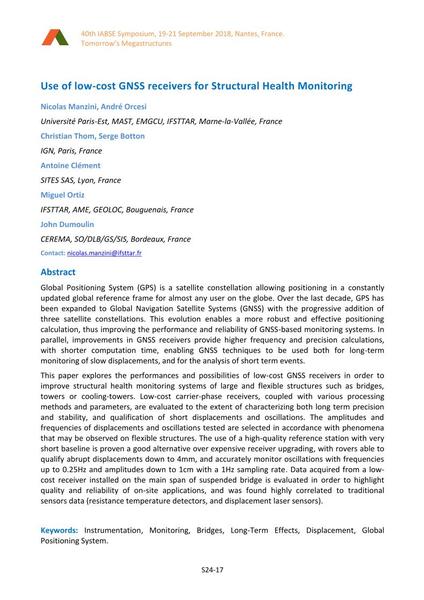Use of low-cost GNSS receivers for Structural Health Monitoring

|
|
|||||||||||
Bibliografische Angaben
| Autor(en): |
Nicolas Manzini
(Université Paris-Est, MAST, EMGCU, IFSTTAR, Marne-la-Vallée, France)
Andre Orcesi (IGN, Paris, France) Antoine Clément (SITES SAS, Lyon, France) Miguel Ortiz (IFSTTAR, AME, GEOLOC, Bouguenais, France) John Dumoulin (CEREMA, SO/DLB/GS/SIS, Bordeaux, France) |
||||
|---|---|---|---|---|---|
| Medium: | Tagungsbeitrag | ||||
| Sprache(n): | Englisch | ||||
| Tagung: | IABSE Symposium: Tomorrow’s Megastructures, Nantes, France, 19-21 September 2018 | ||||
| Veröffentlicht in: | IABSE Symposium Nantes 2018 | ||||
|
|||||
| Seite(n): | S24-17 | ||||
| Anzahl der Seiten (im PDF): | 9 | ||||
| DOI: | 10.2749/nantes.2018.s24-17 | ||||
| Abstrakt: |
Global Positioning System (GPS) is a satellite constellation allowing positioning in a constantly updated global reference frame for almost any user on the globe. Over the last decade, GPS has been expanded to Global Navigation Satellite Systems (GNSS) with the progressive addition of three satellite constellations. This evolution enables a more robust and effective positioning calculation, thus improving the performance and reliability of GNSS-based monitoring systems. In parallel, improvements in GNSS receivers provide higher frequency and precision calculations, with shorter computation time, enabling GNSS techniques to be used both for long-term monitoring of slow displacements, and for the analysis of short term events. This paper explores the performances and possibilities of low-cost GNSS receivers in order to improve structural health monitoring systems of large and flexible structures such as bridges, towers or cooling-towers. Low-cost carrier-phase receivers, coupled with various processing methods and parameters, are evaluated to the extent of characterizing both long term precision and stability, and qualification of short displacements and oscillations. The amplitudes and frequencies of displacements and oscillations tested are selected in accordance with phenomena that may be observed on flexible structures. The use of a high-quality reference station with very short baseline is proven a good alternative over expensive receiver upgrading, with rovers able to qualify abrupt displacements down to 4mm, and accurately monitor oscillations with frequencies up to 0.25Hz and amplitudes down to 1cm with a 1Hz sampling rate. Data acquired from a low- cost receiver installed on the main span of suspended bridge is evaluated in order to highlight quality and reliability of on-site applications, and was found highly correlated to traditional sensors data (resistance temperature detectors, and displacement laser sensors). |
||||
| Stichwörter: |
Brücken Verschiebung Monitoring
|
||||
